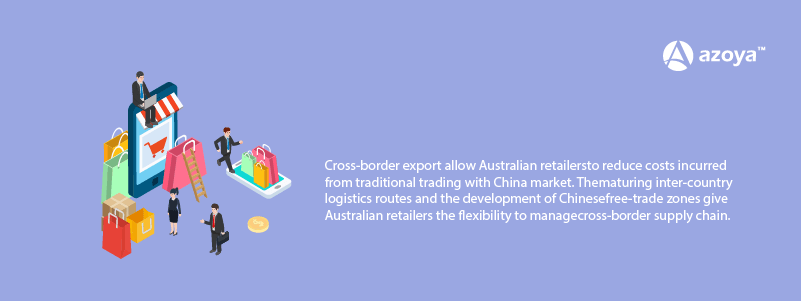Seeking new market opportunities in China and APAC areas
Starting to sell in China via cross-border e-commerce is a strategic leap of faith for many retailers hoping to leave their comfort zone as there will be opportunities just as there are challenges.
by Azoya

Amazon entering the Australian e-commerce market could be one of the biggest buzz for the past few weeks. The United States based e-commerce giant Amazon had made the decision to launch service in Australia, a market with size similar to that of Texas. The move had widely been interpreted as the doomsdays of Australian e-commerce businesses, prompting local business to look for new growth points from overseas market.
More than 50% of Australian shop online and had an average spending of 285 AUD per week[1], a perfect ingredient for Amazon to launch its Amazon Prime services. E-commerce is highly developed in Australia, and people are accustomed to purchasing online and have matured logistics network to deliver order. No language barrier and shared cultural background also ease entry to this new market.
From the macro view, total retail sales in Australia will not have major growth in the next few years. With e-commerce sales projected at 5.6% of total retail sales[2], Australian retailers are going through online transformation, and there’s still room for imagination.
Looking for new market entry point?
Just as Amazon chose Australian market to expand its online business, local Australian retailer should also consider launching business ventures in new markets.
Compared to Australia, China shares similarities in the e-commerce industry. Chinese people enjoy shopping from foreign online shopping websites. Penetration of online shopping in China is expected to reach 68%% nationwide[3] thanks to increasing adoption rate of mobile shopping. People can make orders from their smart phones and pay with different mobile payment options. With consumption upgrade happening in China, 225 million middle class citizens[4] are looking for premium, healthy and affordable luxury products from overseas countries, and Australian products fall into these categories.
China has already been one of the biggest export destination of Australian’s premium products. Apart from traditional trading between the two countries, Australian retailers are increasingly engaged in selling products via cross-border e-commerce, which allow retailers to cut away layers of distribution channels and reach out to more customers at low costs.
Looking beyond China: the APAC markets
Having e-commerce capacities will ease entry to new markets for retailers, as they possess the power to fulfill order generated from multiple sales channels. To satisfy the rising need from overseas market, Australian retailers should focus on establishing international B2C capabilities, which includes strong product sourcing, fulfillment and international logistics. This would give retailers an edge to expand their service radius to globally, avoiding the over-reliance on the saturating domestic retail market.
Cross-border export allow Australian retailers to reduce costs incurred from traditional trading with China market. The maturing inter-country logistics routes and the development of Chinese free-trade zones give Australian retailers the flexibility to manage cross-border supply chain. More importantly, establishing a direct international B2C channels allow direct retail brand exposure in the new market, and cultivate customers at very low cost.
Starting to sell in China via cross-border e-commerce is a strategic leap of faith for many retailers hoping to leave their comfort zone as there will be opportunities just as there are challenges. The challenges are the language barrier, logistics, merchandising and localization, but the opportunities are way bigger than climbing sales: think about bigger opportunities Asian wide. Both East Asia and the South-east Asia are dense with population, and there are big demands for high-quality products.
By establishing a regional product distribution center in Hong Kong, retailers can expand in all four direction: going North to satisfy Chinese, Korean and Japanese consumers, who will contribute to most of the orders, going East and South to satisfy Malaysia, Indonesia and Singapore demands, going West to explore rising markets such as Thailand, Vietnam and Myanmar. All of these markets are full of opportunities, and China could be just the key to unlock the next generation of cross-border retailing.
[1] ABC (2013)
[2] PFSweb
[3] iResearch
[4] Figure quoted from McKinsey Co.